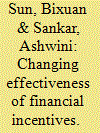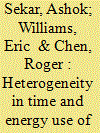| Srl | Item |
| 1 |
ID:
183563


|
|
|
|
|
| Summary/Abstract |
Financial incentives, such as rebate programs, are widely used to promote the adoption of residential solar photovoltaic systems. This paper studies the changing effectiveness of rebate programs as the solar market evolves. We develop a theoretical model to first characterize individual treatment effects then aggregate them to regional effect, and hypothesize that the aggregate treatment effect of rebates first increases and then decreases with declining costs and increasing net metering rate. We empirically test our hypotheses by estimating the treatment effect of rebate rate in California from 2006 to 2017 and its interaction terms with installation cost and residential electricity rate. Results confirm our hypotheses and identify an installation cost of $8.84/W and a residential electricity rate of 22.36c/kWh as the turning points where rebate impacts start to decline. Our findings suggest that front-loaded rebate rate design can be an effective and efficient tool at promoting residential solar adoption.
|
|
|
|
|
|
|
|
|
|
|
|
|
|
|
|
| 2 |
ID:
150900


|
|
|
|
|
| Summary/Abstract |
There is substantial variability in residential energy use, partly driven by heterogeneous behavioral patterns. Time-use is relevant to energy when consumption tracks the time a device is used. Cluster analysis is a promising approach to identify time-use patterns. If clusters with particularly long time use and thus high energy consumption emerge, these groups could merit targeted policy intervention. We investigate these ideas via an empirical study of time use for television watching in the U.S. Three clusters were identified. In 2013, the average time spent watching television by Clusters 1, 2 and 3 are dramatically different: 1.1, 3.5 and 7.7 h per day respectively. While members of Cluster 3 are only 14% of the total population they represent 34% of TV energy consumption. The population of Cluster 3 tends to be older, less employed and less educated. Energy savings per adopter is much larger for Cluster 3, suggesting much higher benefits from efficient devices. These results are relevant to the design of efficiency programs, indicating potential for variable rebates and/or tiered communication. With variable rebates, utilities would offer higher incentives to high-use customers. In tiered communication, utilities would devote more resources to engage customers with larger savings potential.
|
|
|
|
|
|
|
|
|
|
|
|
|
|
|
|